Buy a Jaguar E-Type: The Limora Buying Guide
In its original, undiluted form, Jaguar's E-Type is arguably the most enduring automotive icon the Empire has ever produced. Generations of classic car fans have fallen for the charm of the sleek Coventry cat of prey - and each successive one is fascinated a new when this species extends its claws!
This buyer's guide deals with the Jaguar E-Type Series 1 and 2. For practical reasons, we will still refer to the E-Type in general terms without appending the Series 1 and 2 designation each time.
There are a lot of things to consider when buying a Jaguar E-Type. That's why we've created this Jaguar E-Type buying guide to cover the most important points. That way, when you go to view the car, you'll know exactly which places to inspect.

Position: Sales Manager
Updated: 12.07.2021

The current market situation of the Jaguar E-Type
The E-Type was never threatened with extinction; many examples survived the Swinging Sixties. The fixed-head coupés (FHC) and especially the 2+2 are now somewhat overshadowed by the more popular open two-seater (OTS). Purists anyway look to the early phase, i.e. first-series models with 3.8-litre six-cylinder engines produced until autumn 1964.
The so-called flat-floor versions, which were only produced until the summer of 1962, enjoy a special position, particularly in terms of value, with their flat floor assembly, which is at best intended for jockey statures. Despite their technical advantages, the Series 2 models delivered from 1968 onwards were at the other end of the price spectrum.
History of the E-Type
At the 1961 Geneva Motor Show,
the "E" took the sports car world by storm to such an extent that
customers were already queuing up at Browns Lane immediately after its
debut. At first, Jaguar boss Sir William Lyons only expected to produce around 1000 E-Types.
The consistent body mix of sheet steel monocoque and bolted front subframe, derived from the glorious D-Type, is just as much applauded as the fabulous XK engine, fed by three SU carburettors, which also has plenty of racing genes in it. The cleverly designed chassis also keeps up with the powerful and elastic six-cylinder engine, which initially has a displacement of 3.8 litres - and is unparalleled among similar calibres from Aston Martin, Corvette or Ferrari.
Visual characteristics of the various Jaguar E-Type series
In the first decade, around 46,000 coupés and roadsters rolled off the production line in two series,
plus (from 1966) almost 11,000 of the 2+2 coupés. Their enlarged
proportions are not quite as balanced as the basic shape - which hardly
changes during this period.
The first visual changes were made to the transitional model in the late summer of 1967 (Series 1.5), which was henceforth without the glass covers on the headlights
due to US standards. The Series 2 was revealed by the larger "mouth" of
the bonnet and the enlarged indicators and light units, which moved
under the bumper at the front and rear.
Notwithstanding the more powerful engine and the higher level of comfort, Jaguar E-Type Series 2 models can be had at considerably lower prices than models with 3.8 litre displacement. FHC models with a fixed roof are also significantly cheaper than the more popular convertibles (OTS).
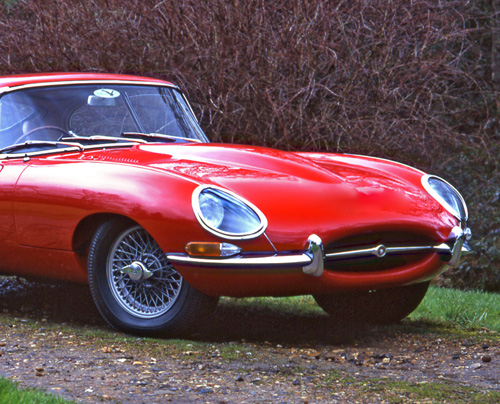
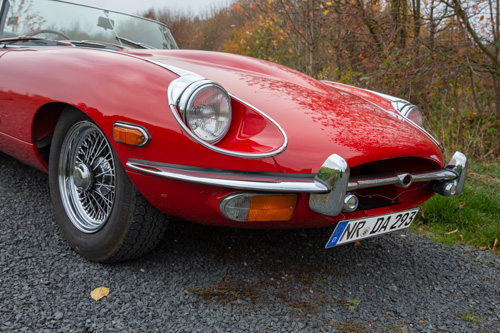
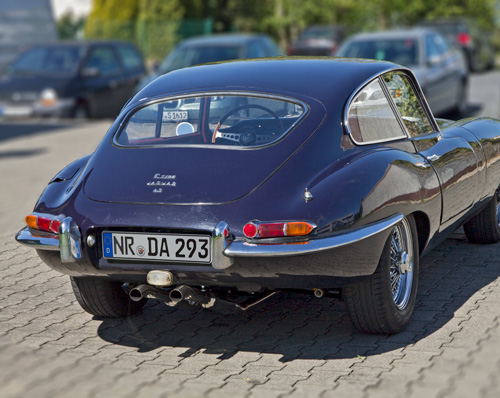
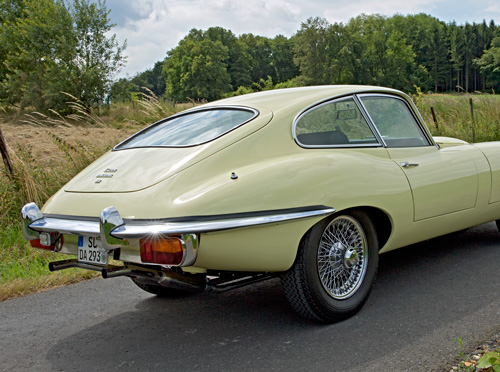
The inner values of the Jaguar E-Type
On the mechanical side, however, the E-Type was constantly optimised in a number of details. The engine underwent the most significant evolution: from October 1964, 4.2 litres of displacement were state of the art, and among other things, an improved cooling system ensured greater stability. This change was accompanied by an update to a fully synchronised four-speed gearbox, which replaced the robust but antiquated Moss gearbox (recognisable by the R gear at the front left).
The engine years can be roughly identified by the paint on the cylinder head: very early 3.8s shone in pumpkin orange until October 1961, later ones are painted gold. The same applies to the early 4.2s, whereas the Series 2 engines all had silver heads. Nowadays, however, the right colour alone is certainly no guarantee that the combination of head and block fits - and is actually mounted in the right chassis…
Cat's whistle?
A revelation for any enthusiast is, of course, a completely authentic XKE original. The fate of such a sale find, which resourceful contemporaries like to call garage gold, happens to only a few… Even those survivors that have been kept on the road for years on a shoestring budget have long been offered in (more or less) restored condition. However, this is where the wheat is separated from the chaff, because all too often the work done does not meet the standards that are now demanded on the market for good examples.
For E-Types formerly rooted in the USA, for example, restorations carried out there were often carried out according to the motto "fast and furious" with a lot of filler, in order to quickly sell the vehicle to the man or woman with a supposed increase in value. In the meantime, however, Jaguar's once most important sales market is also applying higher standards for the protection of species.
What else should you look out for in the most important categories to avoid falling into a tempting trap?
Bodywork
As already mentioned, many big cats have already undergone a bodywork treatment - some even several times. It is therefore better to get to grips with supposedly healthy parts of the bodywork using magnetic strips and an endoscope. Serious, obvious rust defects at the core points of the monocoque are now rare.
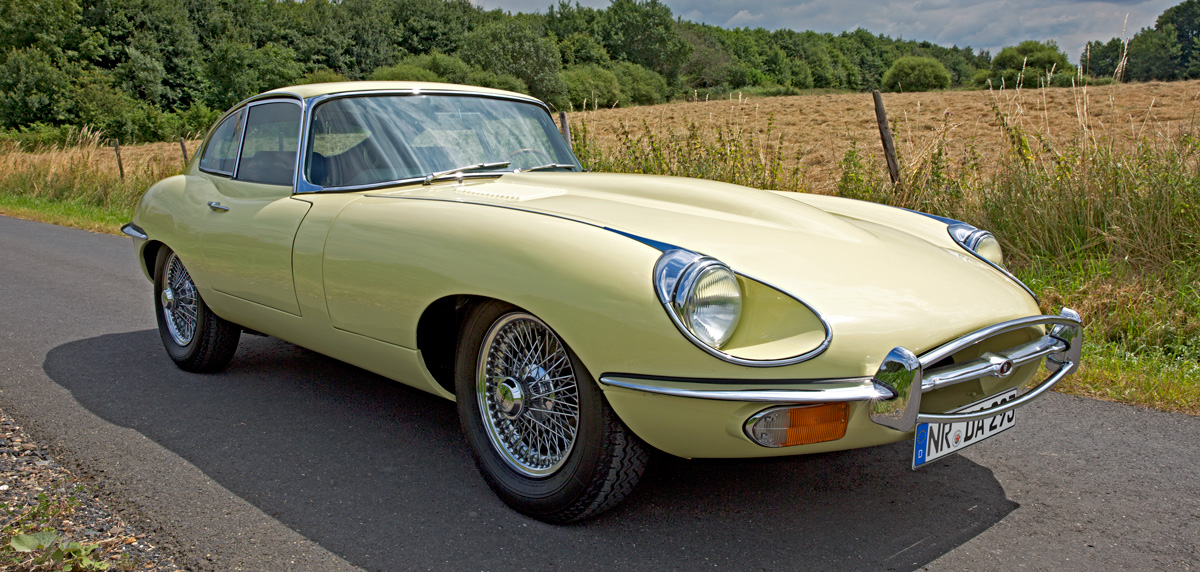
Rust-prone areas on the Jaguar E-Type
Classic sources of corrosion on the monocoque are the areas of the massive sills, which are unfortunately also blessed with plenty of cavities, and the A-pillars. Cosmetic botches are conceivable almost everywhere, especially on the rear wheel arches. The wheel arches and the spare wheel recess should also be observed, as should the entire rear section below the bumper. In addition, the lower edges of the doors and the transition from the floor panels to the inner sills and at the front to the bulkhead.
A known problem area is the sheet metal section under the battery. Its support plate has a drain that should actually be connected to a hose. This is often missing, so that a dangerous mixture of acid and water can find its way in…
Keyword subframe: The clever, two-part construction that accommodates the engine and front axle is bolted to the monocoque at four reinforced points each. The lower mounting points in particular are at risk of rusting, as they are located in the splash water area.
The brazed mesh itself, which consists of high-strength square and round tubes, may appear to be in good health at first glance - but from the inside it rusts terribly. One reason for this is accident repairs, where unprofessional welding attempts sooner or later lead to material fatigue (cracks!).
The bonnet hinging points should also be checked, because their condition indicates possible accident damage. If the front-mounted tubular frame, which holds the bonnet, is warped and has not been professionally straightened (or replaced), telltale gaps will result anyway.
The gap between the bonnet and the cowl is the main indicator of the overall condition. If the bonnet sits evenly here, serious accidents are rather unlikely.
Drive
The characteristic face of the DOHC engine should first of all bring a smile to your face. All the more so when the three quintessentially British two-inch SU carburettors are installed. For the 1968 model year, as a result of the stricter US exhaust emission limits, only two 175 Strombergs were used - which, thanks to the ugly secondary air ducting, do not necessarily ensure brilliant performance. However, a conversion to the original specification is feasible, meanwhile also with completely new carburettor kits.
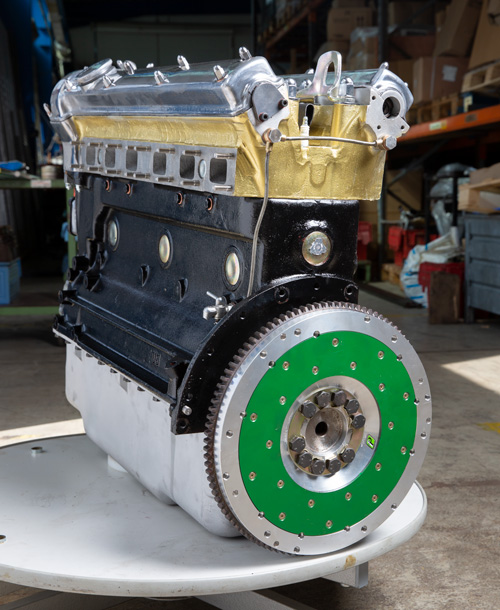
Conversion to SU carburettor
When doing this, you should pay attention to the right differential: Later US versions tend to be equipped with the shortest rear axle ratio of 3.54:1, which promotes wear and tear. Ideally, the ratio is indicated on a metal plate on the diff housing. Complete differentials are interchangeable, although Series 1 originals were equipped with limited-slip differentials (bearing the abbreviation LS = Limited Slip).
Back to the engine: The English like to call Jaguar's century-old engine bulletproof, and in principle they are absolutely right. Powerful and at the same time suitable for everyday use, the powerful XK double-octane engine is certainly capable, although around nine litres of (20W-50) mineral oil should be warmed up properly. Avoiding continuous revs above 4500 rpm also prolongs the driving pleasure with the long-stroke engine, which, if it is fit, reaches its full torque at just under 4000 rpm anyway.
Conversion to SU carburettor
When doing this, you should pay attention to the right differential: Later US versions tend to be equipped with the shortest rear axle ratio of 3.54:1, which promotes wear and tear. Ideally, the ratio is indicated on a metal plate on the diff housing. Complete differentials are interchangeable, although Series 1 originals were equipped with limited-slip differentials (bearing the abbreviation LS = Limited Slip).
Back to the engine: The English like to call Jaguar's century-old engine bulletproof, and in principle they are absolutely right. Powerful and at the same time suitable for everyday use, the powerful XK double-octane engine is certainly capable, although around nine litres of (20W-50) mineral oil should be warmed up properly. Avoiding continuous revs above 4500 rpm also prolongs the driving pleasure with the long-stroke engine, which, if it is fit, reaches its full torque at just under 4000 rpm anyway.
Engine noises and possible causes
If the engine does not idle smoothly and stably after a cold start, this is often due to worn throttle spindles. If, on the other hand, the six-cylinder engine runs smoothly in all speed ranges, this indicates a healthy mechanical condition, at least for the time being. At operating temperature, the oil pressure should then be at least ten lbs. As soon as medium engine speeds around 3000 rpm are reached, at least 40 lbs are considered healthy.
Apart from the rattling of a worn timing chain, there are different ways of interpreting various engine noises. The direct valve train equipped with tappets, for example, can make itself heard with a discreet ticking sound.
A whispering sound is more of an alarm signal here, because the valves
may have worked themselves (too) far into their seats and the clearance
is thus reduced to a minimum.
Tip: Make sure that the carburettor pistons are filled with sufficient fresh damper oil!
Other possible engine problems
Valve or tappet guides, on the other hand, can become a problem on the exhaust side as a result of overheating, because they become loose and move upwards towards the camshaft. This can be prevented by special retaining plates for retrofitting, which are often used during engine overhauls.
You should also consider such an intervention if there is a lot of dripping at the joint between the engine block and the gearbox bell housing after the test drive. This indicates that the sealing of the crankcase is weak due to age - which can only be replaced by removing the complete drive unit.
Modern seals
The conversion kit to a modern rotary shaft seal goes without saying in the context of an overhaul, as does the use of a modern composite head gasket. As far as the budget allows, many other modifications are possible. A sensible update is, for example, the conversion kit to a modern oil filter cartridge or the installation of a stiffened cast aluminium oil pan for improved heat dissipation.
Especially for the XK engine, the spare parts situation is almost paradisiacal anyway. Almost all components can be replaced due to age or wear. The question is rather whether there is anything at all that does not exist.
Recently, Jaguar has even started offering brand new grey cast iron blocks in the 3.8-litre version again through its Classic division - which were not available for almost 50 years!
The Chassis of the Jaguar E-Type
As ingenious as the design is, the rear axle in particular can turn into a mammoth task when it comes to servicing and repairs! This applies, for example, when the handbrake pads, the rear brake discs, the oil seals of the side drives on the differential or the universal joints of the cardan shaft need to be replaced: For all these repairs, the rear axle unit must be completely dismantled. Without this, however, the brake pads can be changed! If the four suspension struts and the rubber bushings of the trailing arms do not show any abnormalities, the installed axle can at least be tested on a lifting platform in terms of locking effect: If one wheel is turned, the opposite wheel should move in the same direction. Otherwise, the limited slip differential is defective - or non-existent.
Wear parts on chassis and steering
Like the rubber bushings at the rear, the front axle's counterparts (known to be particularly susceptible to wear) are available in various degrees of hardness as PU versions. Often, such an update is already done - although it is possible to overdo it with overhard race bushings on an E-Type that has never been used on the race track.… If suspicious cracking noises still occur, the suspension joints are often worn out. When replacing them, you should also opt for improved accessory versions of the original.
The same applies to the usual suspects in the steering system, i.e. the tie rod ends. The system itself is otherwise considered to be less susceptible. Sometimes, the silent bearings of the steering gear are in the process of disintegrating, which causes the steering to develop a certain life of its own. To ensure that steering commands are carried out quickly again, the installation of PU bearings is recommended here as well.
Wear parts on the brake system
As far as the brakes are concerned, apart from the usual wear and tear, there are no major design weaknesses to be mentioned. The early Dunlop disc brake of the Series 1 is not exactly famous for its extreme bite; the Girling system of the Series 2 is considered to be somewhat better. Traditionally, people like to upgrade in this respect, also because they can now draw from the full range - and the system can be upgraded to a four-piston brake caliper with internally ventilated discs!
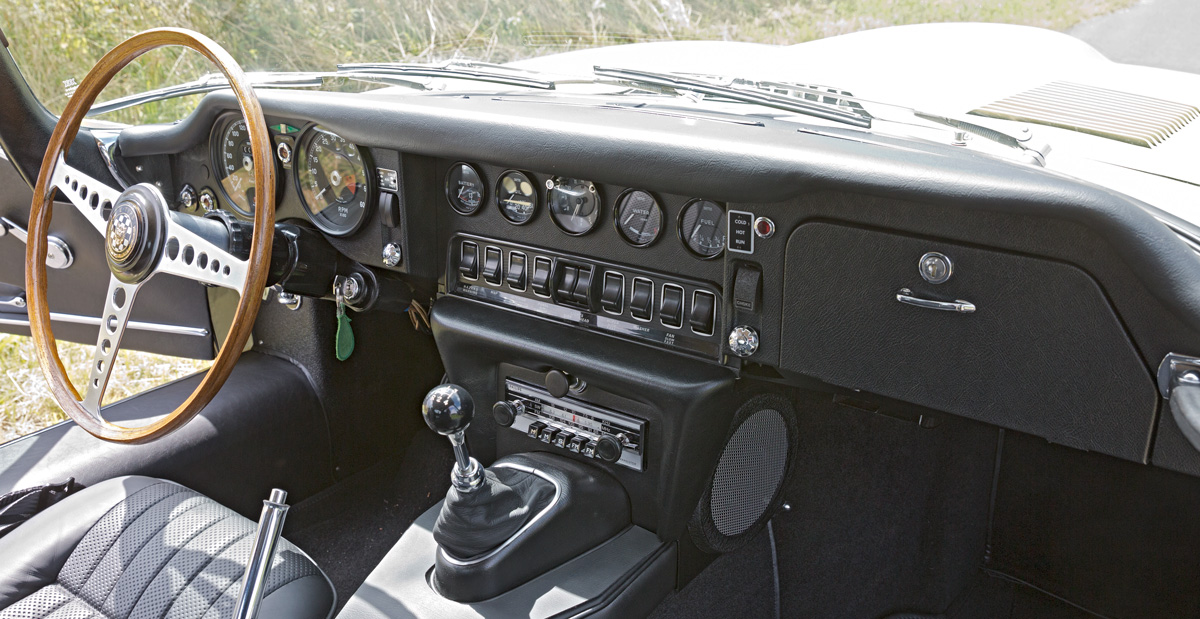
Electrics
Plus to ground: This typically English peculiarity can be found in the early 3.8 Series 1 variants, whose electrical system is powered by a DC generator. In itself, this is not a problem, but one should, for example, avoid charging a smartphone via an adapter on the cigarette lighter… With the introduction of the upgraded 4.2-litre engine in 1964 came the three-phase current lima and the pole reversal to negative ground.
Otherwise, the keyword Lucas is omnipresent in the E-Type's electrical system. But you will be spared any scary stories, especially if the typical bullets in the wiring harness are properly plugged in and the connectors are treated to a little protective grease here and there.
If the current still does not flow properly, this is often due to old, tattered wiring harnesses whose insulation is in the process of disintegrating. In this case, it is only logical to replace the entire wiring harness, especially since the cable colours can then be correctly assigned to the consumers in the vehicle electrical system.
Our conclusion on buying an E-Type
In view of the varying quality levels of the spare parts used, it is not always easy to categorise the condition of a restored E-Type as good, better or excellent. Extensive documentation helps immensely in this regard. If the history of the car can be traced back to its birth at Browns Lane, you can almost assume that the car is a perfect match - assuming matching numbers, of course!
If in doubt, the Jaguar Daimler Heritage Trust archive can help. Certificates with the vehicle's core data can also be produced in Warwickshire on request for a fee of £50 (plus VAT).
Anyone who sets their sights on the E-Type should therefore be fundamentally critical.
Even if its coat shines like silk, it is not always treated as carefully as it deserves. This starts with the regular lubrication of universal joints and chassis components - and doesn't stop with the valve clearance check of the engine. Service records from a competent source are good, but a critical look at the grease nipples, for example, can't do any harm…